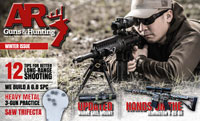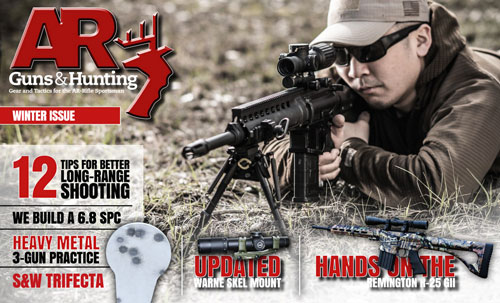Featured in AR Guns & Hunting, a FREE Digital Magazine
Three-gun competition is the fastest-growing shooting sport in the United States. Participants engage in various courses of fire, known as stages, neutralizing targets in the shortest time possible. Each stage may require use of rifle, shotgun or pistol, and often at least two of the three. Stages are usually custom-constructed for a given match, so unknown targets at unknown distances from improvised or unstable platforms are the norm. These competitions are a great way to enhance practical shooting skills for home defense and to become a more effective predator hunter. Both situations involve shooting under pressure and stress, and both require accuracy without delay. Three-gun’s combination of competing with others and against the clock increases pressure on the shooter. That type of practice under stress is ideal for developing skills that will pay dividends for home defense and predator hunting.
“Shoot fast, don’t miss” is the most common advice given to 3-gun beginners, and while it is somewhat of a joke, it really is what we are after. Anyone who has competed in a 3-gun competition will confirm that the world changes when the buzzer sounds. Heart rates quicken. Mouths go dry. Focus narrows. In this sea of adrenaline and tunnel vision, speed and accuracy are required. Such practice is invaluable to the predator hunter, who must control his adrenaline and excitement and at the same time shoot accurately upon demand with little advance notice.
Perfect practice makes perfect performance, or so the saying goes. So what does perfect practice look like for 3-gun? There are many drills for reloading weapons and making transitions. These are very important skills for 3-gun, but not the focus of this article. Competing in 3-gun calls for accurate rifle shooting from unstable platforms at random distances. Punching paper can be effective target practice, but shooting steel reactive targets adds a dimension that paper targets can’t match. Steel gives immediate feedback to the shooter, and this is particularly useful when setting up speed and accuracy drills. Besides, every 3-gun competition will include shooting steel, so practicing what you will see in competition is wise.
MGM Targets (Mike Gibson Manufacturing) makes the premier steel targets for 3-gun competitions. I have yet to compete in a match that did not include many MGM targets. They are also commonly used by law enforcement and military trainers. Made of high-quality AR500 steel, MGM targets are built to last. Two great steel targets from MGM are the Colt Auto-Popper and the new Econo Long Range target. The MGM Colt Auto-Popper features a self-resetting AR500 steel knockdown plate, which gives a visual confirmation to accompany the audible steel ping from a hit (about $200 with optional legs). The Econo Long Range target is affordable, effective and easy to set up. An AR500 plate comes pre-mounted to a shot absorbing hanger in 6-, 8- or 10-inch versions. Tough rubber Last Stand corner brackets accept user-supplied rebar to complete the target. These brackets allow the user to vary the leg height for uneven terrain and enable fast set-up and tear down. The MGM Econo Long Range target ranges in price from $76 for the 6-inch to $115 for the 10-inch gong version.
Rifle skills used in 3-gun competitions have many direct applications. Practicing with steel targets is a great way to prepare for competition. The reactive engagement steel targets offer can’t be matched by ordinary paper targets. Practicing on steel targets offers hours of skill development for the practical shooter, be that for home defense or predator hunting. The variation in shooting scenarios is only limited by one’s imagination. Give steel a try and you will be hooked on hearing the ping of lead on steel.
Safety
Smart shooters wear eye and ear protection whenever using firearms. In addition, we follow the four rules of firearms handling: Treat all firearms as if they are loaded, never point a firearm at anything you are not willing to destroy, be sure of your target and what is behind it, and finger off the trigger until you are on target and ready to fire. With steel targets there are two additional safety concerns: Follow manufacturer’s instructions for minimum shooting distance, and take precautions to avoid starting a fire. MGM targets used in this article require a minimum standoff distance of 100 yards for nonmagnum rifle (200 yards for magnum) and 15 yards for pistol. Small bullet fragments can and will ricochet off steel targets and can cause injury if used closer than manufacturer’s specifications. In addition, having filmed steel targets being engaged at night, I can say that sparks do fly. Take fire precautions such as clearing the area around a steel target of dry tinder, wetting down the area around a steel target as a precaution, and even avoiding steel target use in extremely fire-prone conditions.
For more AR-15 gear, tactics, tips, and hunting stories check out AR Guns & Hunting.
Never miss an issue!








